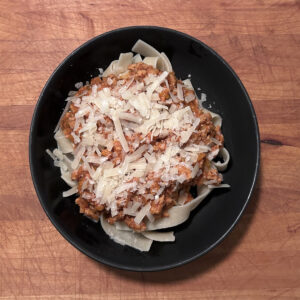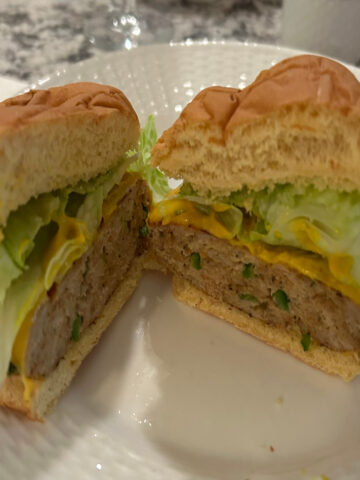
Jump to:
Introduction:
Italian cuisine is a symphony of flavors, a celebration of fresh ingredients, and a testament to the art of culinary craftsmanship. Within its rich repertoire of dishes lies a comforting classic: Chicken Bolognese. Originating from the vibrant culinary landscape of Bologna, this dish offers a delightful twist to the traditional Bolognese sauce by incorporating succulent chicken.
Unraveling the Recipe:
At its core, Chicken Bolognese is a marriage of tender chicken, aromatic vegetables, tangy tomatoes, and a symphony of herbs and spices. The process begins with finely diced onions, carrots, and celery sautéed in olive oil until they release their sweet aroma, forming the flavor base known as "soffritto."
Next comes the star of the show: lean ground chicken. Browned to perfection, it infuses the sauce with a rich, savory flavor while maintaining a light and delicate texture. To enhance the depth of taste, a splash of white wine is added, followed by a generous pour of tomato passata or crushed tomatoes, transforming the sauce into a vibrant crimson hue.
But what truly elevates Chicken Bolognese to culinary excellence is the slow simmering process. Over gentle heat, the flavors meld together, creating a velvety sauce that coats each strand of pasta with sheer indulgence. The combination of spices in this recipe adds a final flourish, infusing the dish with an aromatic bouquet that tantalizes the senses.
Reducing Acidity:
Tomatoes, a key ingredient in Bolognese sauce, are naturally acidic. While this acidity adds brightness and depth to the sauce, it can sometimes overwhelm the palate. Milk acts as a natural acid neutralizer, softening the sharpness of the tomatoes and mellowing out the overall flavor profile. The result is a smoother, more nuanced sauce that is both comforting and satisfying. For more information regarding the use of milk in Italian dishes, see this article, Why is adding milk in Bolognese a common practice in Italy.
A Healthier Twist:
One of the hallmarks of Chicken Bolognese is its lighter profile compared to its beef counterpart. By substituting chicken for beef, the dish retains its robust flavor while offering a leaner alternative that's perfect for health-conscious individuals. Packed with protein and lower in fat, it's a guilt-free indulgence that doesn't compromise on taste.
Don't Forget about the pasta:
While traditionally served with spaghetti or tagliatelle, Chicken Bolognese is a versatile delight that welcomes experimentation. My personal favorite is high quality Pappardelle, or you could make the pasta from scratch. For a healthier twist, opt for whole wheat or gluten-free varieties.

Chicken Bolognese
Ingredients
- 2 Tablespoons Extra Virgin Olive Oil
- 1 Medium Yellow Onion, Finely Diced
- 2 Large Carrots, Finely Diced
- 2 Stalks Celery, Finely Diced
- 2 Cloves Garlic, Thinly Sliced
- 1 Cup Dry White Wine
- 1 Pound Ground Chicken
- 1 Tablespoon Freshly Chopped Basil Divide amount of fresh Basil by 3 if using dried.
- ½ teaspoon Dried Marjoram
- ½ teaspoon Dried Rosemary Ground
- ½ teaspoon Dried Sage
- ½ teaspoon Dried Thyme
- ½ teaspoon Dried Oregano
- ¼ teaspoon Dried Parsley
- ¼ teaspoon Red Pepper Flakes
- ½ teaspoon White Pepper
- ½ teaspoon Better Than Bouillon - Beef
- 2 Tablespoon Double Concentrated Tomato Paste
- 2 Cups Tomato Sauce
- ½ Cup Whole Milk
- ¼ Cup Pasta Water
- 1 Pound Pappardelle Pasta
- 1 Cup Parmigiano Reggiano
Instructions
- Heat olive oil in a deep frying pan or stew pot. Saute onions, carrots, and celery for 5-10 minutes with medium heat.
- Add garlic and cook for approximately 30 seconds. Once you smell the garlic cooking, add white wine and simmer for 10 minutes.
- Add ground chicken and stir to brown. Continuously break the chicken to small pieces.
- Add all spices and stir to mix well.
- Add beef bouillon, tomato paste, and tomato sauce.
- Reduce heat to low, cover, and cook for 2 hours.
- Add whole milk and simmer on low for one hour.
- In a pot, add water and salt. Bring water mixture to a boil. Add Pappardelle and cook to al dente. Before you drain the pasta water, reserve ¼ cup and add to the sauce. Mix it thoroughly.
- Drain pappardelle.
- Place the pasta back in the pot and pour the sauce over the pasta. Mix gently to allow the sauce to coat the pasta. Serve in bowls with freshly grated Parmigiano Reggiano cheese.



Leave a Reply